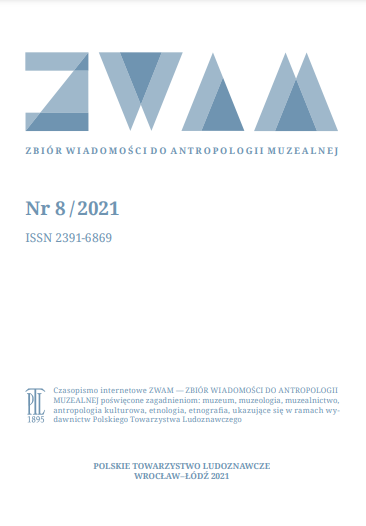Kolekcja etnograficzna Muzeum Tatrzańskiego
Działalność Juliusza Zborowskiego w latach 1945-1949
DOI :
https://doi.org/10.12775/ZWAM.2021.8.06Résumé
Juliusz Zborowski, pierwszy dyrektor Muzeum Tatrzańskiego w latach 1922-1965, swoim zaangażowaniem i prężną działalnością wpisał się w historię polskiego muzealnictwa. W efekcie, w dwudziestoleciu międzywojennym, zakopiańska placówka została uznana za wzorcowe muzeum regionalne. W 1950 roku, po kilku dekadach społecznej działalności, Muzeum zostało upaństwowione co spowodowało zmiany w jego strukturze i zarządzaniu. Celem niniejszego artykułu jest opisanie kolekcji etnograficznej, która znajduje się w Muzeum Tatrzańskim i procesu jej rozbudowy po II wojnie światowej aż do upaństwowienia instytucji. Zborowski nakreślił wówczas kierunki kolekcjonerstwa i zabiegał o wykupienie z prywatnych rąk mniejszych zbiorów i pojedynczych okazów. Chciał ochronić to, co pozostało z najdawniejszych okazów sztuki i ludowego rękodzieła. Stworzył katalog zbiorów, który składa się z ręcznie zapisanych licznych kartek informujących o obiektach do dziś stanowiący ważne źródło wiedzy o obiektach. Prowadził korespondencję z licznymi naukowcami z całej Polski. Stanowi ona zbiór ponad 8000 listów i nadaje interesujący kontekst do prowadzenia analizy w zakresie kolekcjonerstwa tamtych lat. Zborowski konsekwentnie kierował działaniami, które stanowiły kontynuację obranych u zarania muzeum celów, a następnie planów określonych po wojnie. Starał się utrzymywać naukowych charakter, którym palcówka szczyciła się kilka dekad wcześniej. Z perspektywy czasu to imponujące dzieło pioniera muzealnictwa w Polsce bezsprzecznie może być wciąż wzorem i inspiracją
Références
Biernacka Maria
: Barbara Bazińska (1918–1994), w: „Etnografowie i ludoznawcy polscy. Sylwetki, szkice biograficzne”, Tom II, s. 16–18.
Błaszczyk-Żurowska Hanna
: Najstarsze fasony podhalańskich gorsetów, w: „Rocznik Podhalański”, Tom VII, s. 203–232.
: Muzealne zbiory etnograficzne w latach 1889–1920 i najstarsze kolekcje prywatne, które przeszły na własność Muzeum Tatrzańskiego, w: Zbiory etnograficzne Muzeum Tatrzańskiego, red. Anna Liscar, Zakopane: MUZEUM TATRZAŃSKIE, TOWARZYSTWO MUZEUM TATRZAŃSKIEGO, s. 10–31.
: Prywatne kolekcje etnograficzne z lat 1880–1920, w: Zbiory etnograficzne Muzeum Tatrzańskiego, red. Anna Liscar, Zakopane: MUZEUM TATRZAŃSKIE, TOWARZYSTWO MUZEUM TATRZAŃSKIEGO, s. 32–34.
Gładysz Mieczysław
: Juliusz Zborowski. Z historii etnografii Podhala, w: „Etnografia Polska”, Tom XI, s. 44–61.
: O działalności etnograficznej i muzealnej Juliusza Zborowskiego, w: Juliusz Zborowski. Pisma podhalańskie, red. R. Hennel, Tom I, Kraków: WYDAWNICTWO LITERACKIE, s. 16–54.
Kolago Władysława
: Łyżniki podhalańskie, w: „Polska Sztuka Ludowa”, Tom II, z. 9–10, s. 11–32.
Kozak Anna
: Kolekcja etnograficzna w latach 1950–1999, w: Zbiory etnograficzne Muzeum Tatrzańskiego, red. Anna Liscar, Zakopane: MUZEUM TATRZAŃSKIE, TOWARZYSTWO MUZEUM TATRZAŃSKIEGO, s. 54–69.
: Juliusz Zborowski i kolekcja etnograficzna Muzeum Tatrzańskiego w latach 1918–1939, w: „Rocznik Podhalański”, Tom XIV, s. 174–209.
Kroh Antoni
: Kolekcja im. Szymańskich w Zakopanem, w: „Polska Sztuka Ludowa”, Tom XXIX, nr 1–2, s. 9–12.
Kwiecińska Magdalena
: O badaniach etnograficznych i spostrzeżeniach na temat rękodzielnictwa na Podhalu, w: „Rocznik Podhalański”, Tom XII, s. 21–37.
a: Edyta Starek (1911–1983), w: „Etnografowie i ludoznawcy polscy. Sylwetki, szkice biograficzne”, Tom VI, s. 234–238.
b: Zbiory Muzeum Tatrzańskiego w czasie II wojny światowej, w: „Rocznik Podhalański”, Tom XIV, s. 210–243.
Malinowski Kazimierz
: Co wnosi nowego ustawa o ochronie dóbr kultury i o muzeach?, w: „Ochrona zabytków”, Tom XV, nr 2, s. 3–10.
Paryski Witold Henryk
: Przemówienie wygłoszone na sesji zorganizowanej z okazji 50 zjazdu Polskiego Towarzystwa Ludoznawczego oraz 90 rocznicy powstania Muzeum Tatrzańskiego w Zakopanem, w: „Rocznik Podhalański”, Tom IV, s. 347–355.
Pawlikowski Jan Gwalbert
: Reorganizacja Muzeum Tatrzańskiego, w: „Wierchy”, Tom I, s. 250–253.
Piłsudski Bronisław
–1921: W sprawie Muzeum Tatrzańskiego (O urządzeniu działu ludoznawczego), w: „Rocznik Podhalański”, Tom I, s. 147–188.
Radecki Gerard
: Kazimierz Malinowski — muzeolog, w: „Muzealnictwo”, Tom LVIII, s. 60–73.
Rak Maciej
: Materiały do dziejów polskiej dialektologii i etnologii, Kraków: UNIWERSYTET JAGIELLOŃSKI/WYDZIAŁ POLONISTYKI
Rak Zofia
: Kolekcja łyżników w Muzeum Tatrzańskim, w: „Rocznik Podhalański”, Tom X, s. 147–172.
Rokosz Mieczysław
: Towarzystwo Muzeum Tatrzańskiego im. Dra Tytusa Chałubińskiego w Zakopanem. Narodziny — ludzie — dokonania, w: „Kwartalnik Historii Nauki i Techniki”, nr 3–4, s. 111–127.
Średniawa Helena
: Helena Roj-Kozłowska — Rytardowa (1899–1955), w: „Rocznik Podhalański”, Tom IV, s. 243–247.
Trebunia-Staszel Stanisława
: Muzeum Tatrzańskie jako laboratorium dziedzictwa. Część I, w: „Journal of Urban Ethnology”, Tom XVI, s. 217–231.
Zborowski Juliusz
: Wspomnienia I, w: „Ziemia”, R. 24, nr 1–2, s. 5–9.
: Z działalności Muzeum Tatrzańskiego im. T. Chałubińskiego w Zakopanem, w:
„Etnografia Polska”, Tom V, s. 354–359.
: Z dziejów ludoznawstwa i muzealnictwa na Podhalu, w: „Rocznik Muzeum Etnograficznego w Krakowie”, Tom VI, s. 35–115.
: Słownik gwary Zakopanego i okolic, Zakopane–Kraków: WYDAWNICTWO MUZEUM TATRZAŃSKIEGO
Znamierowska-Prüfferowa Maria
: Polskie muzealnictwo etnograficzne w okresie 25-lecia PRL, w: „Lud”, Tom LIII, s. 419–452.
Strony internetowe
Talenty Podhala, film, 1952, zdj. Mieczysław Wiesiołek, http://www.repozytorium.fn.org.
pl/?q=pl/node/6691 (data odczytu: 08.04.2021).
Téléchargements
Publié-e
Comment citer
Numéro
Rubrique
Licence
© Magdalena Kwiecińska 2021

Cette œuvre est sous licence Creative Commons Attribution - Pas de Modification 4.0 International.
1. Autorzy udzielają wydawcy (Polskiemu Towarzystwu Ludoznawczemu) licencji niewyłącznej na korzystanie z utworu w następujących polach eksploatacji:
a) utrwalanie Utworu/przedmiotu prawa pokrewnego;
b) reprodukowanie (zwielokrotnienie) Utworu/przedmiotu prawa pokrewnego drukiem i techniką cyfrową (ebook, audiobook);
c) wprowadzania do obrotu egzemplarzy zwielokrotnionego Utworu/przedmiotu prawa pokrewnego;
d) wprowadzenie Utworu/przedmiotu prawa pokrewnego do pamięci komputera;
e) rozpowszechnianie utworu w wersji elektronicznej w formule open access na licencji Creative Commons (CC BY - ND 4.0).
2. Autorzy udzielają wydawcy licencji nieodpłatnie.
3. Korzystanie przez wydawcę z utworu na ww. polach nie jest ograniczone czasowo, ilościowo i terytorialnie.
Stats
Number of views and downloads: 457
Number of citations: 0



